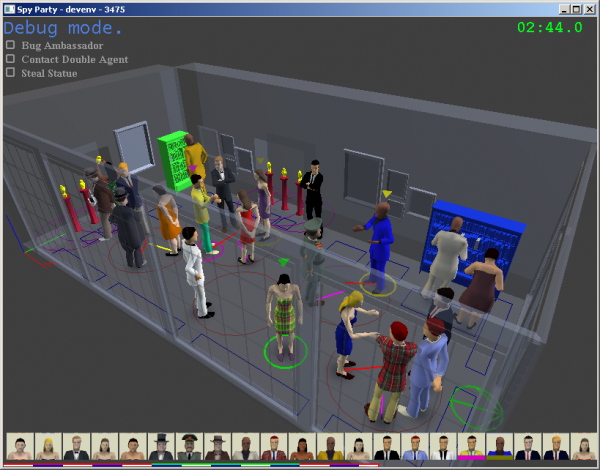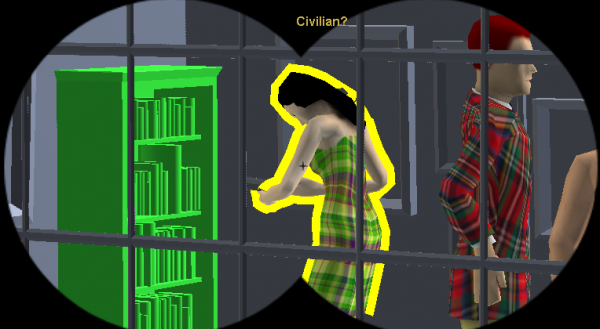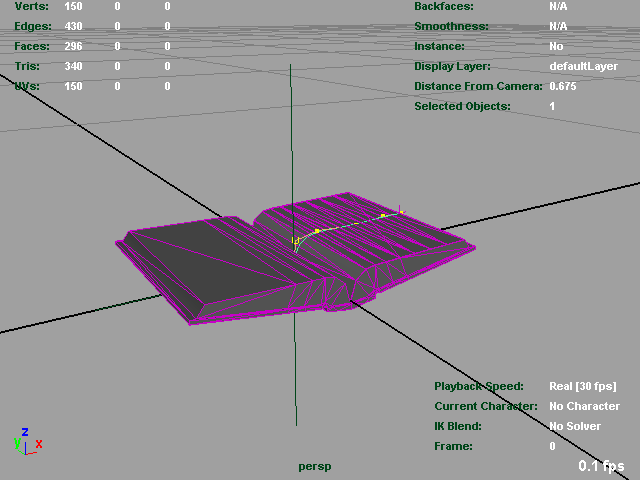Re-re-re-designing a Mission, Part 1
As I teased at the bottom of the last post, I’ve been redesigning and reimplementing what I call “the bookshelf mission”. My good friend and Spore art director Ocean Quigley tells me I shouldn’t call it “the bookshelf mission” because that doesn’t sound very cool and spy-like. If that bothers you, you can call it “the mission where you pick up the hidden microfiche1 and take it to another dead drop by various forms of subterfuge”. One great thing about working on spy games is that you can basically take any situation, regardless of how absurd, and wrap a spy fiction around it. I mean…


Truth be told, I’m just not worrying about the fiction right now; I’m completely focused on the core gameplay, and making it as deep and interesting as I possibly can, and I’m 100% confident that no matter where the design leads me, the results won’t be as absurd as Moonraker.
The old bookshelf mission mission was one of the more interesting missions in the SpyParty gameplay prototype, for a number of reasons. First, let me describe the mission, hopefully for the last time, since I just gutted it. :)
Here’s the current test level, called the ballroom:

Yes, it’s a box, with windows on two sides. In addition to ignoring the fiction, I’m also not worrying about level layouts very much yet! Every playtest you’ve read about in the press has been in this box. I’ve got the geometry for a couple more levels built, but haven’t needed to trot them out yet to keep things interesting, so they’re on the back burner for now.
Back to the bookshelves. You can see there are two of them in this level, one blue and one green. You can see some NPCs at the bookshelves, reading. I’m the woman in the plaid dress with the green triangle over her head. Don’t shoot me, I’m trying to explain something.
The NPC AI will occasionally decide to go to the bookshelves, take a book out, page through it for a bit, and then put it away, and go do something else. As the Spy, you can of course do the same thing.
The old bookshelf mission went like this:
- Your goal is to move a book from one of the bookshelves to the other. You can choose while playing whether you move it from the blue to the green, or vice versa, and that’s part of the strategy, since they have different levels of occlusion due to location and nearby people traffic.
- For this example, let’s say you start at the blue bookshelf.
- You can pick up a book like the AIs, and you’ll sit there and read it.
- While you’re reading it, you have two affordances2, you can Put the book away like the AI, or you can Pretend to put the book away, but actually hide it in your jacket.
- If you put the book away, you look exactly like the AI when they put it away.
- But, if you hide the book, the animation is a little different. This is a hard tell, which I’ll talk about at length in another post, but it basically means it’s something the AI will never do, so if the sniper sees this clearly, you’re made.
- Once you’ve got the book hidden, you can go over to the green bookshelf. It’s not usually a good idea to beeline right from one bookshelf to another, because the NPCs rarely do that, so go talk to some people first, or look at some artwork.
- This is where things got a little overly complex. At the green bookshelf, you can either Pick up another book, in which case you have a hidden book from the blue bookcase and a book from the green bookcase in your hands, or you can Fake pick up a book but really take the hidden book out, in which case you’ll have a book from blue in your hands and nothing hidden.
- If you’re holding a book, then you have the option to put the book away.
- But, if you picked up a green book, you could then Swap the held and hidden books, so you’d have the book from blue in your hands, and a hidden book from green.
- Once the book from the blue bookcase is in your hands, whether it got there from a fake pickup and unhide, or swapping, if you put it away normally you’d accomplish the mission.
If you think that’s complicated to understand reading it here, you should have tried playing it. As I’ve said before, I’m wholeheartedly invested in the Blizzard Depth First, Accessibility Later development style, but man, you need people to be able to figure out how to put a damned book away while they’re playtesting your game. There is text displayed when an affordance is available, and one of them for this mission was “Fake Pick Up Book with Hidden and Hold It”. I can hardly parse that sitting here reading it, let alone when I’m worried somebody is going to shoot me in the head if I screw up.

It may have been a trainwreck from a learning standpoint, but the affordances were designed this way for a reason. The complexity was a direct result of the design goal that you always be able to “play it cool” if the sniper’s laser swept over you and he or she started paying attention to what you were doing at the bookcase. You always needed the option to do exactly what the NPCs would do at any moment (assuming you weren’t in the middle of playing a hide animation or whatever), and these affordances gave you that option, at the cost of clarity.
So, a redesign was in order, but…
Once people learned the state machine, it was actually a good mission with many interesting characteristics I wanted to preserve. For example, it was the only mission that took place across space in the level instead of at a point. It was two-part, with tells at either end, which made it hard for the Spy, but rewarding when you pulled it off. The Spy got to choose the order, so the Sniper was never sure which bookshelf to be watching for late in the match. It had a nice version of David Sirlin’s yomi layer concept, in that since it was hard, Snipers would assume Spies would not choose it. Of course, this made Spies choose it. It had fixed known locations where it would happen, so it could be camped, but while camping it, the Sniper was not looking elsewhere. Etc.
Yikes, it’s 4:23am. Okay, more on this redesign tomorrow…











